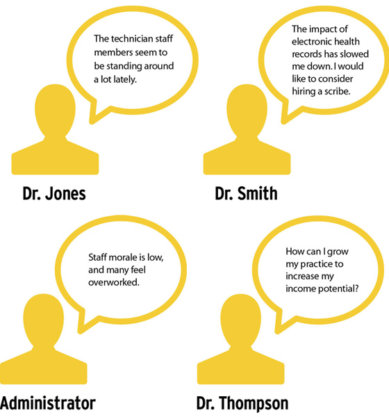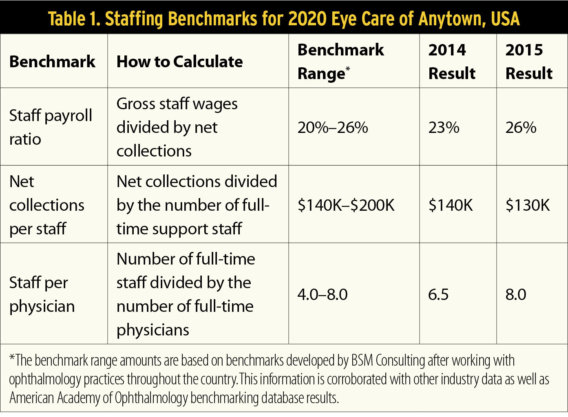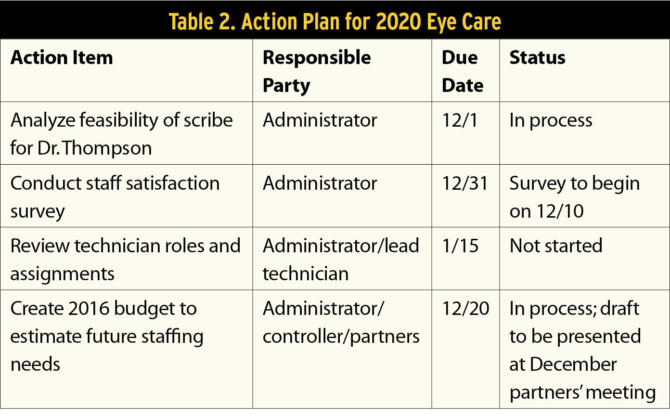In an increasingly complex health care environment, making sure your practice is profitable and has the ability to conquer operational challenges is harder than ever. Implementing ICD-10, maintaining physician productivity and operational efficiency, monitoring human resources and billing—the challenges are numerous. To thrive in this environment today, physicians and practice administrators need to have a disciplined, process-oriented approach to problem solving.
In order to arrive at a diagnosis and action plan for their patients, many physicians use the SOAP method—an acronym for Subjective, Objective, Assessment, and Plan. The SOAP method can also be applied to practices that are facing operational challenges—that is, practices with a particular practice management issue that must be addressed. When performed correctly, SOAP results in an action plan that likely can resolve whatever issue ails the practice.
To illustrate how the SOAP method can be applied in the business setting of the practice, I will present a case study of the fictional 2020 Eye Care, a three-doctor group in Anytown, USA.
2020 Eye Care has grown in recent years and now has 29 full-time staff members, compared with 27 a year ago. Dr. Thompson, who has been with the practice for 2 years, has seen rapid increases in his productivity but still lags behind the other two partners. At a recent partners’ meeting, the growing staff was a key topic.
SUBJECTIVE
Subjective issues in practice operations come in many forms. In this step of SOAP, participants describe their general perceptions of a problem or the current symptoms of the practice.
Some of the symptoms described by 2020 Eye Care included the following:

The issues described by the parties at the practice vary, and, without additional assessment, prescribing a solution is difficult.
OBJECTIVE
In the objective step of the SOAP method, participants gather data to help analyze the subjective symptoms. One way to accomplish this when measuring operational efficiency is through the use of financial benchmarking. Similar to diagnostic testing with patients, in the objective step certain data points are analyzed and compared with a range of results, indicating where the practice falls in that spectrum.
When measuring operational efficiency or practice profitability, it is important to compare results against previous time periods or industry benchmarks. Table 1 illustrates common staffing benchmarks and includes comparisons with industry standards that can help 2020 Eye Care make a proper diagnosis during the assessment phase.

ASSESSMENT
In the assessment stage, by marrying the subjective symptoms with objective analysis, the hope is that an accurate diagnosis is possible. With the right data, someone using the SOAP method should be able to determine the root cause of an issue and prescribe a solution that can lead to improvement. Often, unfortunately, it is not as simple as that. Similar to applying the SOAP method to a patient, it is possible that a practice manager applying SOAP to a practice still ends up far away from an accurate diagnosis. In this situation, further testing and exploration is necessary.
In our objective assessment of 2020 Eye Care, we see some interesting trends. After comparing the statistics for 2020 Eye Care with industry standards, our assessment is that the practice is within range on the payroll-ratio and staff-per-physician metrics and a little low on the net-collections-per-staff benchmark. Comparing 2014 to 2015, all three metrics have changed as a result of adding new staff members and of Dr. Thompson’s growing patient volume.
Are the results conclusive enough to make a diagnosis and prescribe a plan? In this case, the answer is maybe. The benchmarks indicate that staffing levels are probably appropriate, but there are still some outstanding issues, such as the reported low staff morale and the feasibility of Dr. Smith’s desire to add a scribe. Because these issues are not resolved, additional analysis is necessary.
PLAN
Assuming a diagnosis has been reached during the assessment, the final step in the SOAP process is to devise an action plan to create improvement. The action plan, which should be documented on paper so all members of the practice can reference it, should include elements for each task, such as the responsible party and the due date, to ensure transparency and accountability for all parties. The action plan should also include an improvement goal that is attainable and measurable within a specific time period. In other words, the participants must identify the necessary steps in the action plan to achieve the particular goal.
Based on the findings of Table 1, 2020 Eye Care should rely on the action plans in Table 2.

POSTOPERATIVE CARE
The SOAP method is not hard to understand, but it can be difficult to execute when tackling practice challenges. It is crucial to monitor the action items on the plan over time to see how they are influencing the determined goals. Change and goal achievement rarely happen overnight, but the overall aim should always be continuous improvement.


